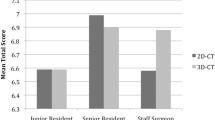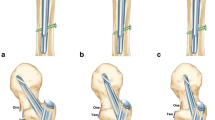Abstract
Objective
The most commonly used imaging device for assessment of fracture reduction is the two-dimensional X-ray fluoroscope. Two recently introduced 3D fluoroscopic devices, the Siremobil ISO-C3D (Siemens) and the C-InSight (Mazor Surgical Technologies), enable the surgeon to obtain spatial information for the assessment of articular reduction and hardware placement. The purpose of this study was to assess the reliability and accuracy of these two 3D fluoroscopic systems in measuring articular reduction in a cadaveric tibial plateau fracture.
Methods
Six cadaveric knee specimens were osteotomized at the lateral tibial plateau and fixed with a maximal articular step-off of 0, 1, 2.5, 5 and 7.5 mm. Each specimen was scanned 10 times with two 3D fluoroscopes, the Siremobil ISO-C3D and the C-InSight. The resulting images were reformatted and interpreted for articular displacements at four different locations at the plateau level and were compared with high-resolution CT scans by an independent observer.
Results
For the non-displaced fracture, no displacement (mean < 0.1 mm) was observed in either modality. The mean scanning time for the ISO-C3D was 2 min, while each C-InSight scan took 20 s. The readings at four different points along the malreduced fractures were similar for most measurements with either of the two modalities. The C-InSight readings were less accurate than those of the ISO-C3D, relative to the CT scan, but most errors were within clinically acceptable limits (< 2 mm) and used less radiation.
Conclusions
Intraoperative 3D fluoroscopes can detect clinically significant intra-articular step-off with acceptable measurement errors, using newer devices that enable the use of a conventional C-arm and reduced radiation.
Similar content being viewed by others
References
Hahn DM (2004) Current principles of treatment in the clinical practice of articular fractures. Clin Orthop Relat Res 423(6): 27–32
Mitchell N, Shepard N (1980) Healing of articular cartilage in intra-articular fractures in rabbits. J Bone Joint Surg Am 62(4): 628–634
De Coster TA, Willis MC, Marsh JL, Williams TM, Nepola JV, Dirschl DR, Hurwitz SR (1999) Rank order analysis of tibial plafond fractures: does injury or reduction predict outcome?. Foot Ankle Int 20(1): 44–49
Moed BR, Carr SE, Gruson KI, Watson JT, Craig JG (2003) Computed tomographic assessment of fractures of the posterior wall of the acetabulum after operative treatment. J Bone Joint Surg Am 85-A(3): 512–522
O’Shea K, Quinlan JF, Waheed K, Brady OH (2006) The usefulness of computed tomography following open reduction and internal fixation of acetabular fractures. J Orthop Surg (Hong Kong) 14(2): 127–132
Atesok K, Finkelstein J, Khoury A, Peyser A, Weil Y, Liebergall M, Mosheiff R (2007) The use of intraoperative three-dimensional imaging (ISO-C-3D) in fixation of intraarticular fractures. Injury 38(10): 1163–1169
Kendoff D, Pearle A, Hufner T, Citak M, Gosling T, Krettek C (2007) First clinical results and consequences of intraoperative three-dimensional imaging at tibial plateau fractures. J Trauma 63(1): 239–244
Kendoff D, Citak M, Gardner MJ, Stubig T, Krettek C, Hufner T (2009) Intraoperative 3D imaging: value and consequences in 248 cases. J Trauma 66(1): 232–238
Rubberdt A, Feil R, Stengel D, Spranger N, Mutze S, Wich M, Ekkernkamp A (2006) [The clinical use of the ISO-C(3D) imaging system in calcaneus fracture surgery]. Unfallchirurg 109(2): 112–118
Linsenmaier U, Rock C, Euler E, Wirth S, Brandl R, Kotsianos D, Mutschler W, Pfeifer KJ (2002) Three-dimensional CT with a modified C-arm image intensifier: feasibility. Radiology 224(1): 286–292
Geerling J, Kendoff D, Citak M, Zech S, Gardner MJ, Hufner T, Krettek C, Richter M (2009) Intraoperative 3D imaging in calcaneal fracture care-clinical implications and decision making. J Trauma 66(3): 768–773
Mazor. http://www.mazorrobotics.com/Using-C-InSight. Accessed 4/1/2011
Richter M, Zech S (2009) Intraoperative 3-dimensional imaging in foot and ankle trauma-experience with a second-generation device (ARCADIS-3D). J Orthop Trauma 23(3): 213–220
Stubig T, Kendoff D, Citak M, Geerling J, Khalafi A, Krettek C, Hufner T (2009) Comparative study of different intraoperative 3-D image intensifiers in orthopedic trauma care. J Trauma 66(3): 821–830
Kluba T, Ruhle T, Schulze-Bovingloh A, Leichtle CI, Schonfisch B, Niemeyer T, Schaefer JF (2009) [Reproducibility of readings of ISO C 3D and CT lumbar pedicle screw scans]. Rofo 181(5): 477–482. doi:10.1055/s-0028-1109180
Brown TD, Anderson DD, Nepola JV, Singerman RJ, Pedersen DR, Brand RA (1988) Contact stress aberrations following imprecise reduction of simple tibial plateau fractures. J Orthop Res 6(6): 851–862
Gosling T, Klingler K, Geerling J, Shin H, Fehr M, Krettek C, Hufner T (2009) Improved intra-operative reduction control using a three-dimensional mobile image intensifier—a proximal tibia cadaver study. Knee 16(1): 58–63
Khoury A, Siewerdsen JH, Whyne CM, Daly MJ, Kreder HJ, Moseley DJ, Jaffray DA (2007) Intraoperative cone-beam CT for image-guided tibial plateau fracture reduction. Comput Aided Surg 12(4): 195–207
Marsh JL, Buckwalter J, Gelberman R, Dirschl D, Olson S, Brown T, Llinias A (2002) Articular fractures: does an anatomic reduction really change the result. J Bone Joint Surg Am 84-A(7): 1259–1271
O’Toole RV, Cox G, Shanmuganathan K, Castillo RC, Turen CH, Sciadini MF, Nascone JW (2010) Evaluation of computed tomography for determining the diagnosis of acetabular fractures. J Orthop Trauma 24(5): 284–290
Author information
Authors and Affiliations
Corresponding author
Additional information
IRB approval was obtained for the cadaveric study in our institution. The work was performed in the Computer Assisted Surgery Laboratory at the Hadassah-Hebrew University Hospital, Jerusalem, Israel.
Rights and permissions
About this article
Cite this article
Weil, Y.A., Liebergall, M., Mosheiff, R. et al. Assessment of two 3-D fluoroscopic systems for articular fracture reduction: a cadaver study. Int J CARS 6, 685–692 (2011). https://doi.org/10.1007/s11548-011-0548-6
Received:
Accepted:
Published:
Issue Date:
DOI: https://doi.org/10.1007/s11548-011-0548-6




